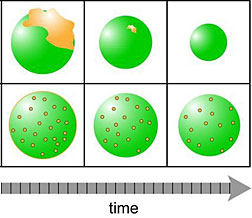- Number 379 |
- January 7, 2012
Pollution hitches ride to Arctic

When airborne particles (green) form before
pollutants known as PAHs (yellow) glob on,
the pollutants dissipate quickly, as shown in
the top row. But when the particles form in
the presence of pollutants, which is what
likely happens in nature, the long-lasting
particles can take the pollutants for a
long-distance ride (bottom).
Toxic pollutants regulated by environmental agencies and produced by fossil fuel and biomass burning reach all the way to the Arctic, even though they should decay long before they travel that far, and now scientists at DOE's Pacific Northwest National Laboratory, Imre Consulting, and the University of Washington know how the pollutants make the lofty journey. The team found that atmospherically abundant, carbon-based secondary organic aerosols, or SOAs, allow toxic polycyclic aromatic hydrocarbons, or PAHs, to tuck inside, providing a vehicle for the pollution's journey to the Arctic. In a one-two punch, the research shows that the PAHs and the SOAs last longer when the pollutants hitch a ride.
"What we've learned through fundamental laboratory studies on model systems has very important implications for long-range transport of pollutants in the real world," said lead author and physical chemist Dr. Alla Zelenyuk of Pacific Northwest National Laboratory. "In this study, we propose a new explanation for how PAHs get transported so far, by demonstrating that highly viscous SOA particles become a protective vessel for PAH transport."
For decades, scientists have been trying to explain how atmospheric particles manage to carry harmful pollutants to pristine environments thousands of miles away from their starting point. The particles collected in areas such as the Arctic show significantly higher concentrations of pollutants than scientists' computer models predict. The results of this study will help scientists understand how pollution is transported over long distances and will help improve air-quality and particle transport models.
Submitted by DOE’s Pacific Northwest National Laboratory
